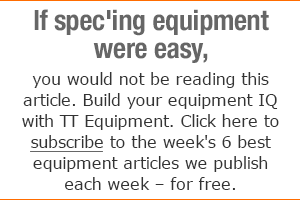Senior Reporter
Stable Demand Lifts Class 8 Sales Past 17,000 Units in November
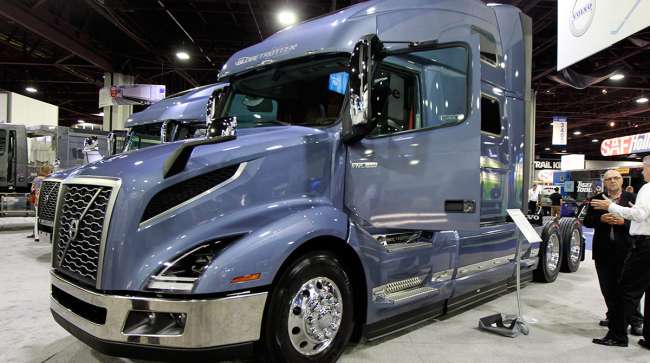
U.S. retail Class 8 sales climbed in November, as analysts expected, and cleared 17,000 units for the third consecutive month, according to WardsAuto.com.
Sales hit 17,488, up 25.4% from 13,943 a year earlier, when demand was weakening after a strong start. Sales this year have been the opposite, softer at the start of the year and now increasing — making for easy comparisons.
“Quite honestly [November] is right on the mark,” Steve Tam, vice president, ACT Research Co., told Transport Topics. “It’s not a surprise that sales are at the level they are at. I think they are doing what they typically do this time of year.”
Year-to-date, sales were 169,987. That was 4% below 177,035 in the 2016 period.
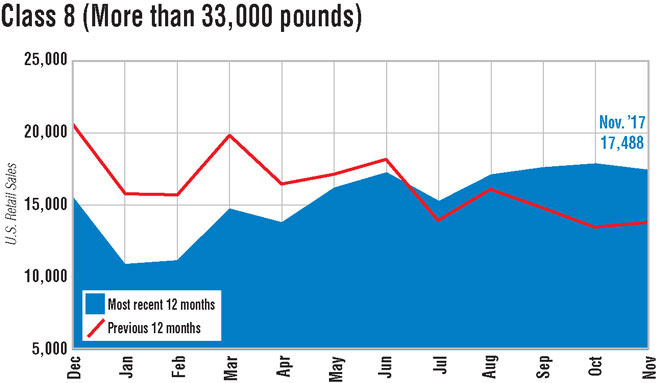
Paccar Inc. was the only truck maker to show a year-to-date gain, riding the performance of its Peterbilt Motors Co. brand, which saw sales rise 12.3% to 27,403 units. Paccar’s Kenworth Truck Co. brand slipped 4.4% in the 11-month period to 25,232.
Looking at just November, all truck makers but one posted year-over-year sales gains, according to Ward’s.
For instance, Mack Trucks secured a 7.7% market share on sales of 1,352, a 23.4% increase from the 2016 period. Mack is a unit of Volvo Group.
“A strong start to the holiday-spending season is helping the overall U.S. economy continue on its path of steady growth. We’re also seeing improved manufacturing levels push freight volumes higher, which has led to an improving longhaul segment,” John Walsh, Mack Trucks vice president of global marketing and brand management, told TT.
“Thanks to these factors, combined with a stable construction segment, we’re seeing some upward pressure on our North American Class 8 forecast total of 235,000 trucks as we wrap up 2017,” he said.
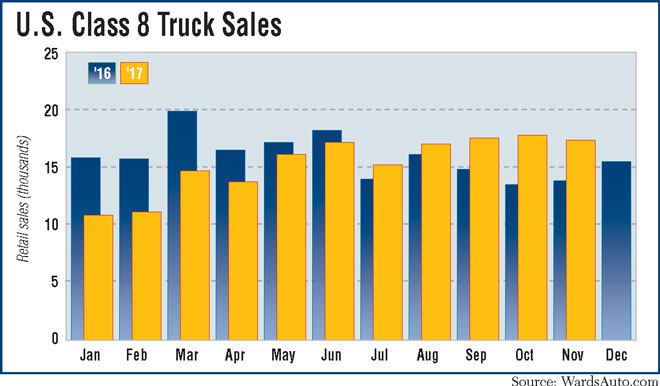
At the same time, ACT is forecasting U.S. Class 8 retail sales will end the year at 195,800.
To get there, December’s sales will need to be 25,903, which would be the highest volume for that month since December 2006 when sales were 26,462.
“Not impossible,” Tam said.
The research company FTR expects U.S. retail sales to be about 189,000 in 2017, with December contributing about 20,000.
November’s volume was what Don Ake, vice president of commercial vehicles at FTR, expected.
“It’s not good, it’s not bad. It’s sustainable,” Ake said. “Things are as normal as they get in this industry.”
Mack’s Walsh said, “November’s retail sales [for Mack] show that we’re maintaining momentum through a year that’s seen us introduce a number of new products to the market.”
Volvo Trucks North America, also a unit of Volvo Group, posted a 7.8% market share on sales of 1,370 trucks, down 5.6% from a year earlier.
“As anticipated, Class 8 retail sales in November remained strong, led largely by demand from the regional haul and longhaul segments, and all signs point toward the market momentum cascading into 2018,” said Magnus Koeck, VTNA vice president of marketing and brand management. “Fleets are clearly investing in trucks equipped with the latest connectivity and active safety technologies, which has positioned us well for 2018 as our new VNR regional haul and VNL long-haul series tractors enter full production.”
Freightliner posted a leading 37.5% share for the month on sales of 6,556, up 18.4% from a year earlier. Freightliner is a brand of Daimler Trucks North America.
Western Star, the niche vocational brand of DTNA, earned a 2% share on sales of 345, down 14.4% from a year earlier.
Kenworth notched the second-highest share in the month, 17.3% on sales of 3,017, surging 53.5% from the 2016 period.
Peterbilt was close behind, earning a 17.1% share on 2,985 sales, up 44.8% from a year earlier.
International Truck, a unit of Navistar International Corp., earned a 10.6% share on sales of 1,858, a 31% increase from November 2016.
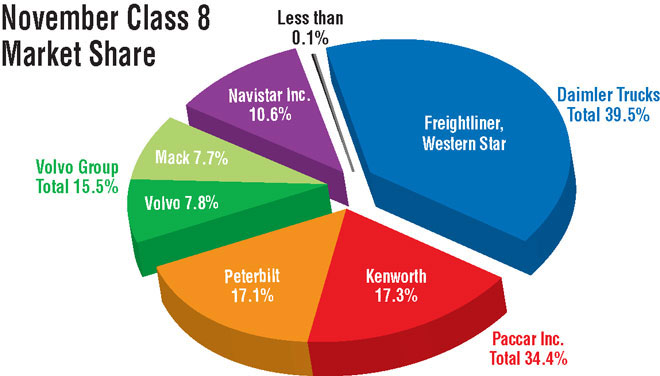
One fleet executive said he relies on interpersonal relationships and truck cab features when it comes to buying trucks.
“We just bought 25 Kenworth T680s, with double bunks and auxiliary power units. We have husband wife teams, they like the double bunks,” said Brad Morehouse, vice president of Morehouse Truck Line, a refrigerated carrier based in Omaha, Neb.
Morehouse operates about 100 trucks, all of which are equipped with electronic logging devices, and have been for several years, he said. “We feel we are ahead of the game.”
“The story as we close in on the end of the year is really looking ahead to next year,” he said. ACT expects U.S. Class 8 sales to jump 26% in 2018 to 247,000 units.
Ake said, “It’s how much momentum you have heading into that next year,” that’s important because sales are typically pulled forward in December for tax reasons, and January is then typically weaker. “So we’ll have to wait until February to see.”
Other truck makers either declined or did not respond to requests for comments.


